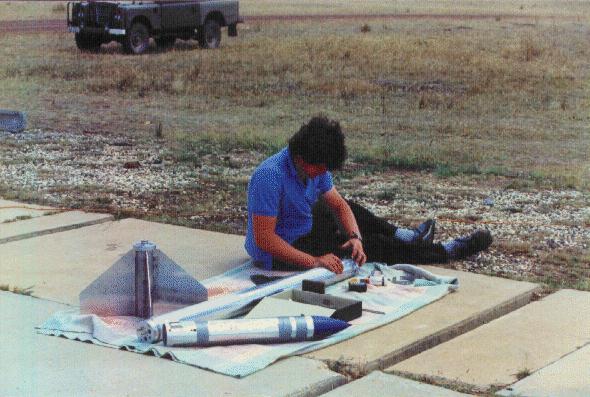In 1995 the Commonwealth provided National Estate funding for a pilot study of Victoria’s aeronautical and astronautical heritage, the first state-level thematic study of its kind. This investigation identified more than a hundred significant sites, three of which related to astronautics. The latter included the Graytown Proof & Experimental Establishment near Puckapunyal; the Ravenhall Static Test Facility in Melbourne’s Deer Park; and the rocket static test site within the former Explosives Factory at Maribyrnong, these last two having been operated by the same agency.
Six years earlier an amateur rocket group comprising mostly Monash University students had launched their first rocket, a liquid fueled vehicle based upon a modified Pacific Rocket Society design. Called AUSROC I it was launched on 9th February 1989 from the Graytown Proof & Experimental Establishment adjacent to Victoria’s Puckapunyal Army Base.[1]

That flight lasted one minute, reaching 3.5 kilometers in altitude and peaking at 600km/h. Although the recovery system failed to operate as planned during this first flight the propulsion system worked very well, as did the electronic and telemetry systems. Privately funded, AUSROC’s ultimate goal was ‘to develop a satellite launch vehicle capable of placing a micro satellite (20-50kg) into a polar low earth orbit.’[2]
This was the country’s first private rocket launch, also marking the renaissance of astronautics in this Australia. Significantly, AUSROC still continues (as the Australian Space Research Institute) providing opportunities for space-related industry and technology developments. Subsequent AUSROC launch vehicles were test fired at the Ravenhall Static Test Facility in Melbourne’s west. Nearly all the Australian rockets launched from Woomera (South Australia) were also test fired here, including all the rockets manufactured at Maribyrnong.[3]
In December 1994 Australian Defense Industries (ADI) sold the site to Victoria’s Justice Department for a proposed prison development. Museum Victoria did offer in March 1995 to dismantle and remove the Ravenhall test rig installation but, perhaps not surprisingly, this was a bridge too far – for the Department.
Whereas the site’s associated magazine and storage facilities (dating from the Second World War) are listed on the Victorian Heritage Inventory (as Historic Places H7822-0174), the rocket test facility appears to have never been afforded any similar protections. Indeed a 2013 heritage assessment of the region makes no mention of the Ravenhall Deer Park site, and a recent Google Earth search suggests all evidence of the rocket test rig has since disappeared.[4]

A similar fate appears to have befallen Maribyrnong’s rocket static test site. There appears nothing in the subsequent heritage assessment or listings acknowledging this structure’s existence, or significance as the test site for all the Australian-made rockets (Malkara, Ikara, Rodinga, Winnin, Murawa, Lorikeet, Kookaburra etc). Perhaps this structure has also been demolished?
Following are some of the 1995 Victorian aeronautical and astronautical survey images of the Maribyrnong and Ravenhall static test sites, and the Graytown launch range site.
[1] Blair, MA. Blair, “AUSROC – Australia’s Amateur Rocket Program,” National Space Engineering Symposium (7th: 1992: Canberra, A.C.T.). Seventh National Space Engineering Symposium 1992 & a Short Course on Spacecraft Engineering: ‘International Co-operation – Regional Space Opportunities’ (Conference Proceedings. Barton, ACT: Institution of Engineers, Australia), 26, https://search.informit.com.au/documentSummary;dn=703245008440150;res=IELENG>
[2] Ibid., 26.
[3] Mark Blair, “AUSROC II Update,” October 1991, https://www.sworld.com.au/steven/space/ausroc/ausroc91_10update.txt
[4] Viki Vaskos et.al, Historic Heritage Assessment: Water for a Growing West Project Stage2 (Heritage Victoria Ref.No.4329), 39, https://www.planning.vic.gov.au/__data/assets/pdf_file/0016/6613/2013-11-Attachment-G-Historic-Heritage-Assessment.pdf










